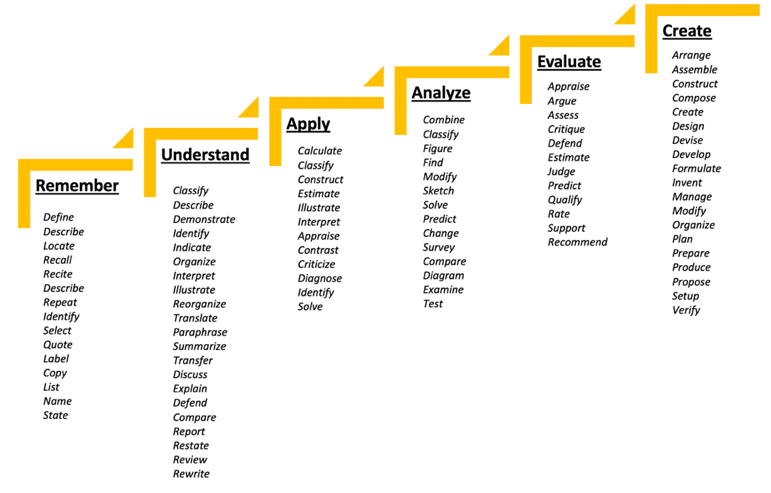Student Learning Outcomes
Student learning outcomes (SLOs) are the specified knowledge, skills, abilities or attitudes that students are expected to attain by the end of a learning experience or program of study. With respect to program-level assessment, SLOs should be informed where appropriate by the following:
- Discipline-related skill set
- Accreditation and other external accountability expectations
- Program goals and objectives
Additionally, program level SLOs should be:
- Meaningful in helping the program to accomplish its mission.
- Should be stated in measurable terms.
- Should reflect the aggregate by focusing on the program as a whole.
- Should be manageable.
Writing Measurable Student Learning Outcomes
Student learning outcomes describe what we expect students to know and be able to do. Using active verbs facilitates clear student learning outcomes. Bloom’s taxonomy can be used as a guiding framework in the development of student learning outcomes. There are three domains of learning in Bloom’s Taxonomy.
- Cognitive (mental skills – knowledge)
- Psychomotor (physical skills)
- Affective (attitude)
Student learning outcome statements should include the following:
- A verb that identifies the performance to be demonstrated.
- A learning outcome statement that specifies what learning will take place.
- A broad statement reflecting the criterion or standard for acceptable performance.
See examples below. Students will be able to:
| Action Verb | Learning Outcome Statement | Criterion |
| apply | knowledge of mathematics, science and engineering principles | in addressing aerospace engineering problems. |
| apply | knowledge of the scientific method | to develop reasoned solutions to address environmental problems. |
| demonstrate | knowledge of contemporary issues | that impact the field of business. |
Action Verbs Aligned with Bloom's Taxonomy
The following is a list of action verbs that can be used in developing student learning outcome statements.

Learning Outcomes Generator
The links below are to free outcomes generators that are designed to walk you through the process of developing measurable outcome statements.
- Learning outcomes generator from Easygenerator.com
https://learning-objectives.easygenerator.com/ - Outcome Generator from the University of Nevada, Reno
https://www.unr.edu/student-services/resources-and-downloads/persistence-research/assessment/learning-outcome-generator
Checklist for Evaluating Outcome Statements
The checklist below can be used to evaluate the quality of your student learning outcome statements. As a general rule, you want to be able to answer yes to all of the questions.
| Question | Yes | No |
|---|---|---|
| Does the outcome support the program goals? | ||
| Does the outcome describe what the program intends for students to know (cognitive), think (affective, attitudinal), or do (behavioral, performance)? |
||
| Is the outcome: Detailed and specific? Measurable/identifiable? A result of learning? |
||
| Do you have or can you create an activity to enable students to learn and demonstrate the desired outcome? |
||
| Can the results from assessing this outcome be used to make decisions on how to improve the program? |
